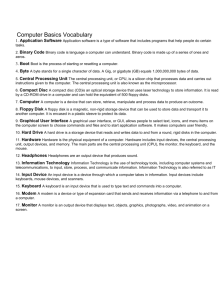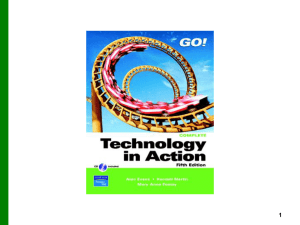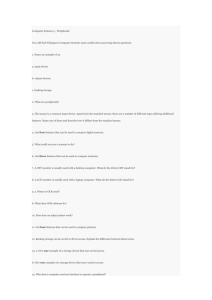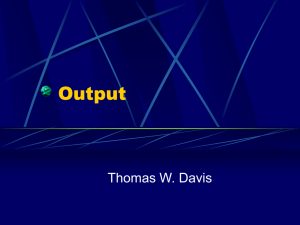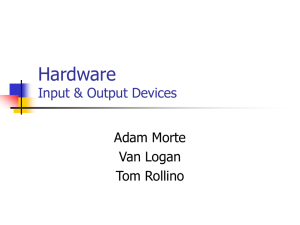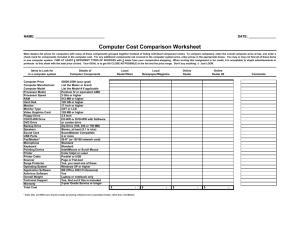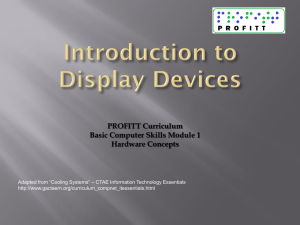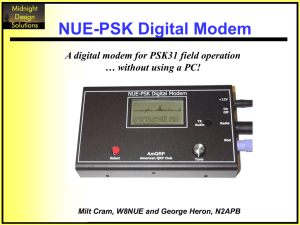hardware-outside
advertisement
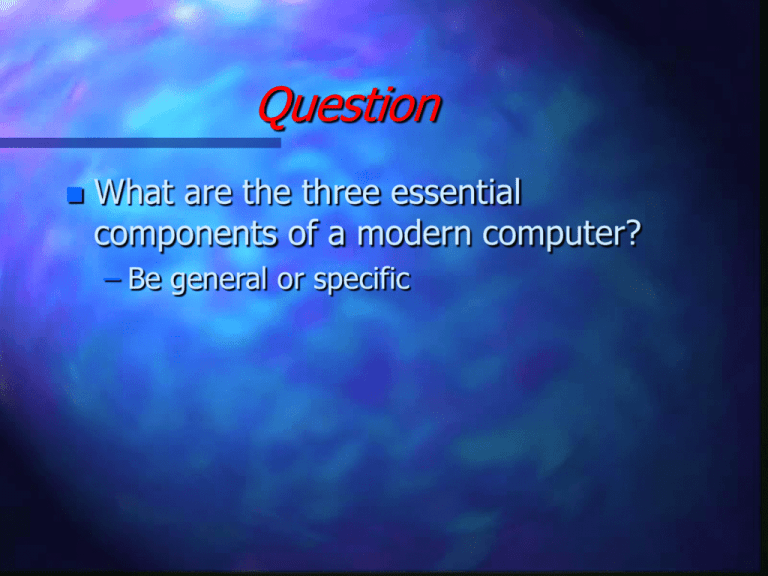
Question What are the three essential components of a modern computer? – Be general or specific Announcement Definition of a Computer A computer is an device that receives information (input), processes information, and outputs information input/output device that processes information Computer Hardware Key parts of a computer Input vs. output Interconnection between parts Essential Parts Box - Central Processing Unit (CPU) Monitor - main output device Keyboard - main input device The Box (CPU) All processing goes through the box A simple input/output (I/O) device Ports on back for connection of input and output devices Disk drives on front for storage I/O Input vs. Output? Classify the following as input or output Monitor Keyboard CPU (The Box) Floppy Drive CD-ROM Printer Scanner Modem Digital Camera CD Writer/Burner Hard Drive LCD Projector Laser Pointer Network Card Bluetooth Card Speakers Monitor LCD Printer Legend Modem HD FD Computer CD-RW Output Input I/O Read - Write Scanner Keyboard Mouse Camera Inside the Box Processor – e.g. Pentium IV Memory – e.g. 256 MB RAM Storage – e.g. Hard Drive, CD-RW Slots & Cards We will cover this on Monday Input: Keyboards Standard keyboard - 101 key, letters, number-pad, function keys Microsoft Natural Keyboard “Ergonomic” design, supposedly better for wrists Wrist support is important The future? Output: Types of Monitors Cathode Ray Tube (CRT) standard monitor, inexpensive, good resolution, good pixel size Flat Panel (Liquid Crystal Display - LCD) – more expensive, prices dropping Buying a Monitor Size is most important factor – Get a 17” CRT or 15” LCD or bigger Note 15” LCD is about the same as a 17” CRT – 15” CRT cheaper but will seem very small Dot size advertised, not that big of a factor Viewable Area – 15.8” for a 17” CRT Maximum resolution – look for at least 1280 x 1024 Monitor LCD Printer Legend Modem HD FD Computer CD-RW Output Input I/O Read - Write Scanner Keyboard Mouse Camera Input: Mice Standard Two-Button: Left button for selecting, right button for properties Wheeled Mouse - Wheel for scrolling Trackball - Inverted mouse Touchpad - Touch/tap sensitive “Eraser”/Joystick Mice: Mechanics Most mice have a round ball and rollers – rollers must be cleaned Newer mice are OPTICAL, using LED and sensor to track movement Input: Scanners Flatbed Scanners - Lay image flat on “copier”like glass panel. Scanning element moves Photo Scanners - Run a single photo through a scanner - photo moves, scanning element stays stationary What you pay for: resolution, color quality, connectivity Speed: USB connection faster than Parallel All scanners on market sufficient for web Input: Digital Cameras Camera without film Pixel resolution measures number of dots Pixel resolution is key: 640x480 vs. 1280x1024 (1.3 Megapixels) vs. 2048X1536 (3.3 Megapixels) Storage can be on flash memory cards, memory sticks, floppy disks, internal, or no storage (web cam) How to unload images is important Question What is the common language in which input and output devices communicate? Answer Ones and Zeros. 10001101010101010000101000101111 10010100101010101010010100110000 01010010101110011011111100010100 110 actually means something to a computer Output: Printers Inkjet Printers - Tiny dots of ink on paper – Can print high quality photos – Ink is expensive! Laser Printers - Laser, plastic toner, and heat; drawback: no color Color Laser Printers - ~$600 and up Dot Matrix Printers Output - LCD Projectors Similar to monitors but project image New to computer market (last 5 years) Expensive, becoming cheaper every day (some under $1000 now) For business and education, some people getting them for home theatre systems Two-way Communication: Modem MOdulator / DEModualter = MO-DEM Converts digital computer signal to analog telephone signal and vice versa Sends and receives information 56K is current standard Connect speeds often slower than 56K Cable Modems Cable Modems convert from cable interface to Ethernet or USB interface. External, $50-$200 to buy Must subscribe to Broadband/ Cable Internet Service through your cable provider Best way to go from home but expensive ($45/month) Cable provider has a monopoly so prices won’t drop DSL Digital Subscriber Line – Works over phone line but doesn’t interfere with phone calls – The speed is much higher than a regular modem (1.5 Mbps vs. 56 Kbps) – Works better closer to phone company – Not available everywhere Network Cards Network cards allow connection to the Internet via ETHERNET Wireless network cards require a wireless router to connect Ethernet is FAST! Storage Media Media refers to the objects on which information is stored Singular of word is medium A CD is a medium for storage, a floppy disk is a medium, … Storage: Magnetic Media “Drive” Storage: magnetic film stores 1s and 0s Hard Drives - Internal, sealed platters Floppy Drive - One flexible platter Zip Drive – Very high capacity floppy Most rewritable storage is magnetic Storage: Optical Media Read Only CD-ROM – 650MB or 700 MB, read only, etched pits drives 32X etc. for speed relative to normal DVD - stands for Digital Versatile Disc, 4.7 Gb (7X CD) CD Burners – Optical Read/Write CD RW – 48x/16x/52x means 48x maximum write speed, 16x max. rewrite speed, and 52x max. read speed Media: CD-R is cheapest, write once CD-RW – good medium for transporting files
